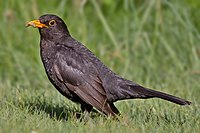
Photo from wikipedia
Abstract Rodents often act as important hosts for ticks and as pathogen reservoirs. At northern latitudes, rodents often undergo multi‐annual population cycles, and the periodic absence of certain hosts may… Click to show full abstract
Abstract Rodents often act as important hosts for ticks and as pathogen reservoirs. At northern latitudes, rodents often undergo multi‐annual population cycles, and the periodic absence of certain hosts may inhibit the survival and recruitment of ticks. We investigated the potential role of common shrews (Sorex araneus) to serve as a supplementary host source to immature life stages (larvae and nymphs) of a generalist tick Ixodes ricinus and a small mammal specialist tick I. trianguliceps, during decreasing abundances of bank voles (Myodes glareolus). We used generalized mixed models to test whether ticks would have a propensity to parasitize a certain host species dependent on host population size and host population composition across two high‐latitude gradients in southern Norway, by comparing tick burdens on trapped animals. Host population size was defined as the total number of captured animals and host population composition as the proportion of voles to shrews. We found that a larger proportion of voles in the host population favored the parasitism of voles by I. ricinus larvae (estimate = −1.923, p = .039) but not by nymphs (estimate = −0.307, p = .772). I. trianguliceps larvae did not show a lower propensity to parasitize voles, regardless of host population composition (estimate = 0.875, p = .180), while nymphs parasitized shrews significantly more as vole abundance increased (estimate = 2.106, p = .002). These results indicate that common shrews may have the potential to act as a replacement host during periods of low rodent availability, but long‐term observations encompassing complete rodent cycles may determine whether shrews are able to maintain tick range expansion despite low rodent availability.
Journal Title: Ecology and Evolution
Year Published: 2022
Link to full text (if available)
Share on Social Media: Sign Up to like & get
recommendations!